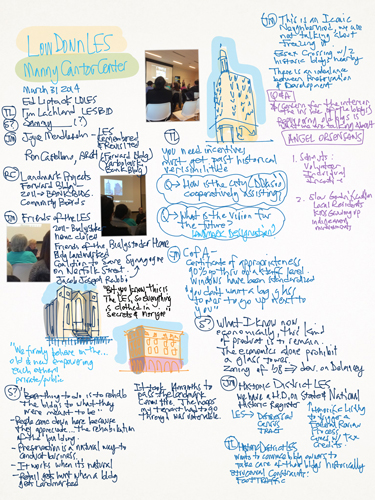April 8, 2014
Urban Evolutions

This is a page of notes scribbled last week during a small presentation on urbanism, gentrification and the Lower East Side, apparently sponsored by the Manny Cantor Center and the online and print magazine The-Low Down.
While there is nothing absolutely ground breaking that was discussed, the panel of architects and developers were forthcoming and informative, and among them was the revelation of Joyce Mendelsohn, a local community activist who wrote LES remembered and revisited. (An informative interview can be found in Cupblog here.) All together, the people who spoke that night were positive and no one spoke badly about other actors (either present or not) involved in the changes being wrought in the bottom right side of Manhattan.
There was much focus on the conservation of architectural history. Of course, there was a slightly different agenda that I would prefer:
1) What could be done to pace and time the unfolding of gentrification (my pet idea: that gentrification is best when it is slow) so as to allow an opportunity to involve the local legacy population to integrate themselves into the dynamic of local business and ownership of private property? Low-Down LES had celebrated James Fuentes in their magazine a couple of years ago. James grew up in the LES and after he graduated from school, he opened up his gallery on Delancey and has done quite well for himself since. At the moment, the James Fuentes Gallery is having a show reprising the Real Estate Show (open until April 27th), a vintage barrio art exhibit that protested the gentrification (ironically, oh the turns of irony!) that changed the LES from the charming yet scary no-go-zone of the 1970's to the (mildly) irritatingly pleasant yes-go zone of today.
and
2) How can spontaneous clean up and improvement by the local residents be encouraged? I'm thinking about broom, rakes and plastic bags, about people getting together to get the fountain to work again in Seward Park, to fix the paving stones there, small stuff that a person might see and have the time and inclination to put right without having to engage layers of bureaucracy to get anything done.
Two more notes to append to this blogpost:
-Let's graphically analyze the LES:
-A central and recurring problem haunts the efforts to improve urban neighborhoods: How do you build to replace or augment an aging and degraded urban property without either obliterating the existing scale with the inevitable increase in unit density (the number of residential and commercial tenants and owners)... or ...otherwise create an artificial simulacrum, a Disneyland, a pastiche of urbanism that we have come to love throughout the years of urban history?
Of course, I intend to provide an answer to these questions in the next blogpost.
Posted by Dennis at April 8, 2014 9:33 AM
Leave a comment